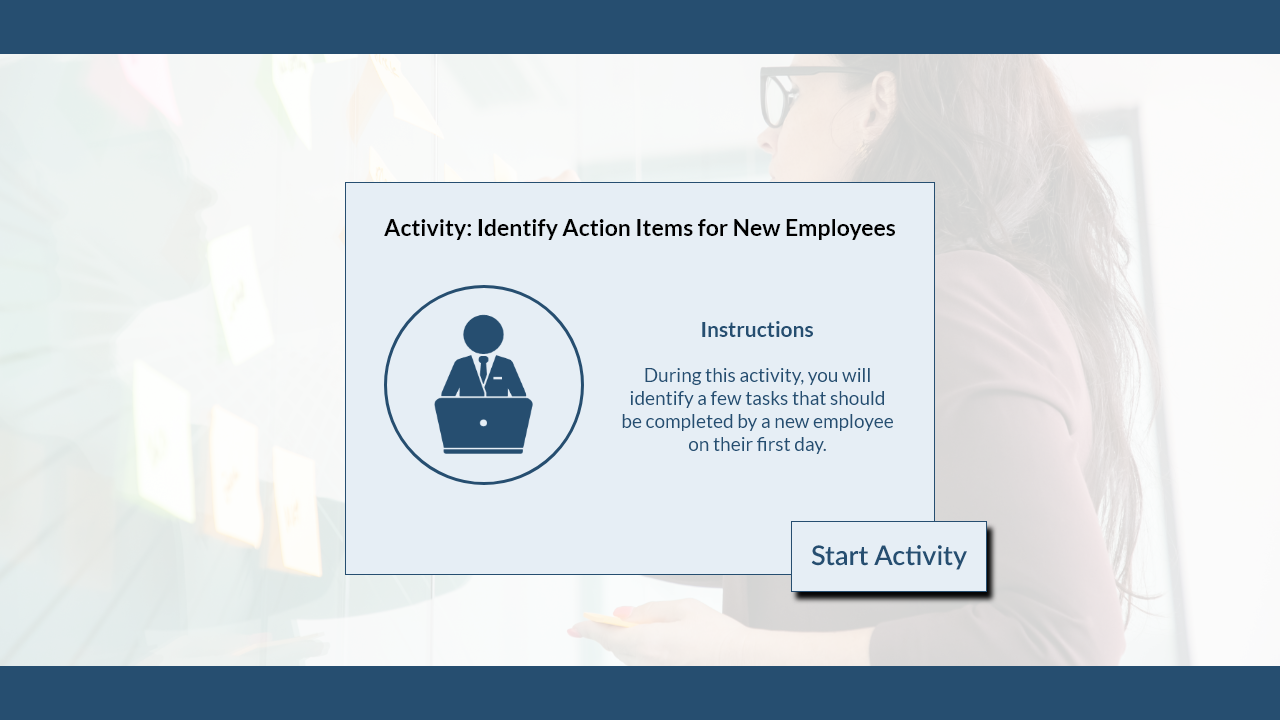Making the First Day Count
Soft Skills for Hiring Teams Welcoming New Employees
Overview
This interactive eLearning project was designed to educate hiring teams on how to prepare for and navigate a new employee’s first day. The project helped hiring teams improve employee onboarding processes by exploring practices that support a welcoming and productive first day for new hires.
Responsibilities: Instructional Design, eLearning Development, Graphic Design
Target Audience: Management/Hiring Teams
Tools Used: GitMind, MS Word, Storyline 360
Budget: Medium to High
Year: 2022
The Problem
The client asked me to design this project to address the constant lack of productivity due to poorly integrated teams. The client expressed the company’s need for a structured onboarding process to improve the approach hiring teams were taking to integrate new employees.
The Solution
To provide an effective deliverable that addressed the organization’s specific needs, I proposed a personalized, scenario-based eLearning course equipped with relevant content and interactive activities that promote retention. This approach allowed learners to establish understanding by demonstrating practical application in a risk-free environment that would later be applied in real workplace situations.
My Process
The client provided me with pre-existing content to build from, so I had a good footing in my thought process and planning for this project. Given the nature of the course content, I determined that an introduction of some motivational concepts and characteristics would be appropriate. I carried out my learning strategies to produce a solid course overview, action map, and storyboard--then took this information and turned it into a functioning prototype.
Instructional Design
Starting out, I revised and added to the pre-existing content. I analyzed and proposed a variety of content solutions that would demonstrate to hiring teams, how to plan for and navigate a new employee’s first day. As a result, I produced a set of measurable, meaningful learning objectives to work with. These objectives served as a guide for my content design decisions going forward. I then, organized the content to ensure it was simple to understand and logically flowing.
I removed information that was irrelevant to the objectives, and I filled content gaps with thorough research and occasional collaboration with the client. Once learning objectives were established, I strategically structured my content to fit learner needs. For example, the foundational focus I set for this particular course was intentional processing. I wanted to ensure that every employee integration process was intentional in promoting productivity and hospitality! To do this, I provided learners with appropriate choices, responsibilities, and influences that tied instruction to the learners’ experiences in the real world.
I implemented multiple interactions and assessment tools to deliver and evaluate information that captures learners’ interests and stimulates an attitude of inquiry. By using a variety of tactics to maintain their attention, learners were able to engage and develop their understanding through practice. To build a positive expectation for success, I designed this course to encourage the learner’s confidence in their competence. Based on the success attributions incorporated, learners are clearly able to see that their success is based on their individual efforts and abilities through intrinsic satisfaction, rewarding outcomes, and equity.
Action Map
After identifying the need and getting approval for the proposed project, I interviewed the client to identify the most significant issues. Creating an action map allowed me to visualize objectives, brainstorm potential solutions and develop action items that led to decision-making for each specified scenario.
Storyboard and Visual Mockups
To thoughtfully structure this course, I developed a storyboard in Storyline 360 that included text and visual mockup elements of course layouts. A slight difference from my typical text-based storyboard. This revision and additional visual detail allowed me to pay a bit more attention to personalization, which was a large component of this course.
This was one of the most straightforward storyboards I’ve had to do, aside from personalization. Developing this storyboard was simple because I have a history of developing training for new employee orientation. I simply sequenced the order of processes regarding welcoming, accommodation, delegation, and productivity to a new employee. I then created situations that allowed the learner to not only feel welcomed on their first day but also be productive.
For example, one of the situations in this course calls for the hiring manager to delegate tasks to the new hire. ln this instance, the hiring manager will have the freedom to determine what the employee should be doing. For example, the hiring manager can assign a time-sensitive report, enlist the new hire to lead the next meeting, or they can suggest the employee get settled in and familiarize themself with the company policies and procedures. One of these options should precede the others and is the correct answer. If the hiring manager answers correctly, the answer will be validated and they will move on to the next situation. If the answer is incorrect, the hiring manager will be led to a branched scenario that allows the hiring manager to experience an unfavorable situation to understand why their selection was incorrect. They will then have the option to approach the situation in a different manner.
eLearning Development and Finalization
I developed a prototype with the programming, illustrations, and animations incorporated. I was intentional in incorporating a variety of interactions to support collaborative learning. By utilizing JavaScript, variables, and conditions, I was able to make this training more personalized.
Personalization was something the client wanted to ensure was incorporated in review of the storyboard. The content, graphics, arrangement, and functionality of the prototype were reviewed and approved by the client. After receiving and applying feedback from the prototype, I finalized the product for delivery.
Results
The client and other key stakeholders loved the course and praised my ability to deliver the product in a time that exceeded initial expectations. After implementation of this eLearning deliverable, I received feedback that learners found the course to be full of applicable information and it has since improved productivity! I’ll take that as a win!









